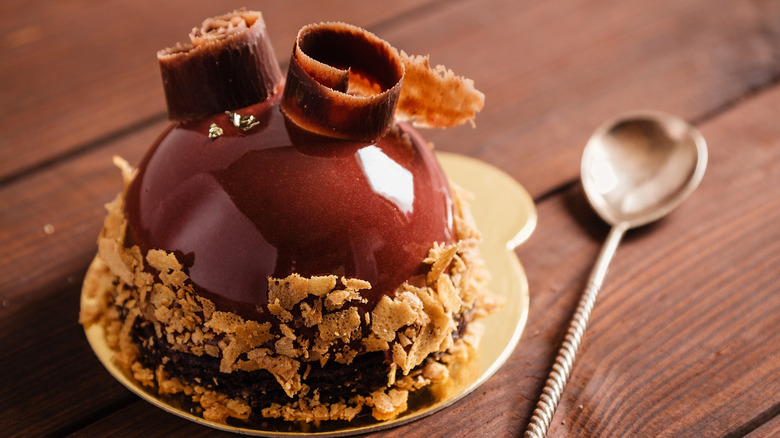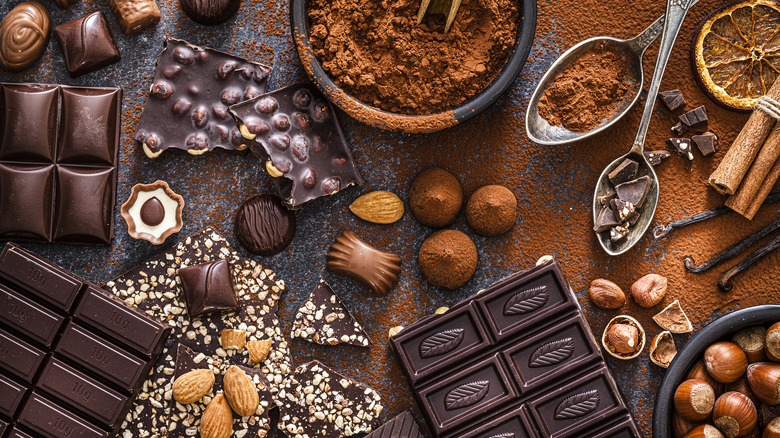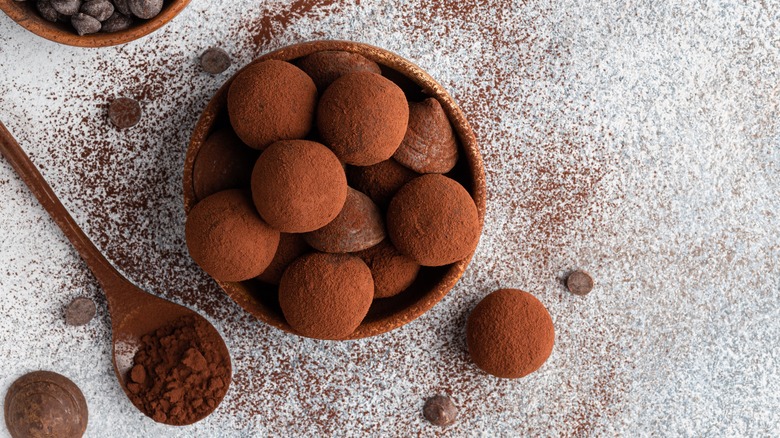How French Chocolate Gets Its Intense Flavor
Few can balance the crunchy yet chewy texture of macarons, craft flaky and exquisitely dainty layers of mille-feuille, or build towers of croquembouche held together with nothing but wispy threads of caramel the way the French do. France has a legendary reputation for its mastery over pastries and baked items, but anyone with an appetite for chocolate will know that the country's prowess extends to its chocolates as well. Considered to be unparalleled in their bold intensity, French chocolates are luxuriously rich — even thought to be a cut above the rest in some ways.
Like most European chocolates, French chocolate has more cocoa butter than its American counterparts, which means it has a richer and smoother texture with a creamier mouthfeel. French chocolate makers also tend to use a higher percentage of cocoa solids, which tones down the sweetness in their confections, increases the cocoa content, and intensifies their flavors instead — making the French version a treat for those who like their chocolates on the darker, slightly bitter side.
Why does cocoa content matter?
French chocolates contain more cocoa butter than American equivalents, use more cocoa solids, and generally lean on the higher side of cocoa content, and that's what makes the chocolates more intense. All chocolate is made by roasting cocoa beans until the hulls separate from the nibs. The cocoa nibs are then ground until a paste-like cocoa liquor forms, which is further pressed to extract cocoa butter. Cocoa butter gives chocolate a smooth and glossy sheen with a melt-in-your-mouth texture whereas cocoa liquor affects the flavor of chocolate — the larger the percentage of cocoa liquor, the more intense and bitter the chocolate will be.
Cocoa butter and cocoa liquor together make up the cocoa content of chocolate. In general, French chocolates usually contain upwards of 26% of pure, unadulterated cocoa butter, 43% of cocoa liquor, and contain anywhere between 62% to 80% cocoa content which is why they have a reputation for being more intense and less sweet.
Additionally, French chocolates also have a higher percentage of cocoa solids, which is the amount of the actual cocoa bean used in the chocolate barring its fatty cocoa butter component. The cocoa solids are what intensify a chocolate's, well, chocolatey flavor and give it a robust bite. A higher percentage of cocoa solids also indicates that there is less room for anything but cocoa — meaning French chocolates tend to have fewer fillers like sugars, fats, and flavorings, making them superior in quality.
French versus other European chocolates
French, like most European chocolate, tends to be more intense than American – but French chocolate also tends to be slightly bitter, darker, and more full-bodied than other European chocolates — such as Belgian and Swiss ones. For example, Swiss chocolate is renowned for its velvety, creamy texture thanks to the quality of the alpine milk that it is made from and the higher amount of fat that it contains.
Belgian chocolate too — though loved the world over for its use of high-quality ingredients and craftsmanship — uses more cocoa butter than French versions. While French chocolate has more cocoa butter than American chocolates, it has less so than its European counterparts, making it just a touch lower in fat as well. Undeniably, Swiss varieties reign in the world of milk chocolates, and Belgian ones offer a darker alternative. However, for anyone who wants a nice dark and crisp chocolate that has good bite, French chocolates come out on top.
The same goes for French truffles: While Belgian truffles have tougher shells of chocolate that are often filled with nut pastes and ganache, French truffles are dipped in toppings and have a thinner outer shell of chocolate that melts more easily on the tongue. Add to that the fact that French truffles also tend to be smaller in size, have fewer ingredients, and have higher cocoa content, and the intense richness and bitter flavor of French chocolate can be tasted even in its truffles.



